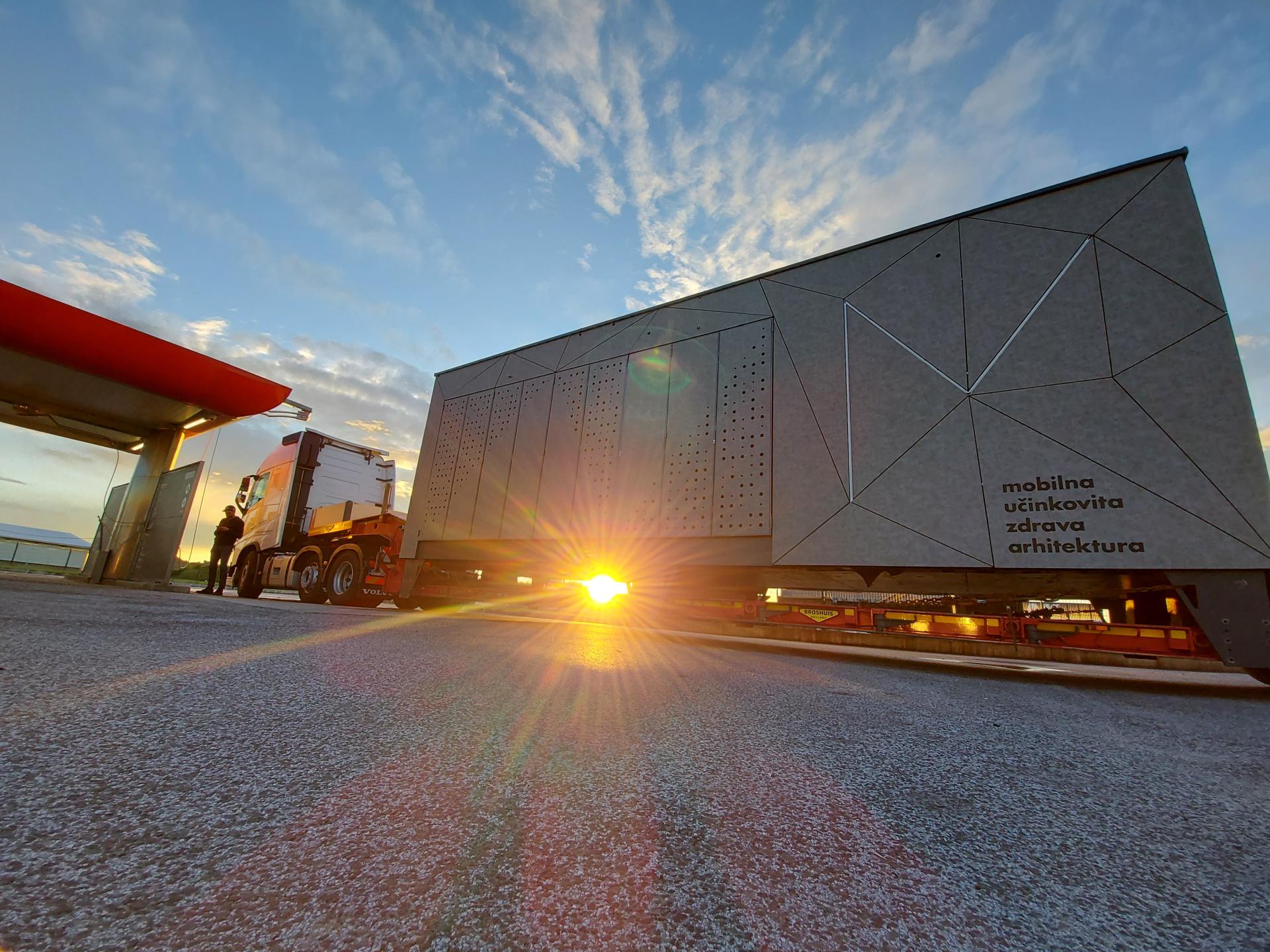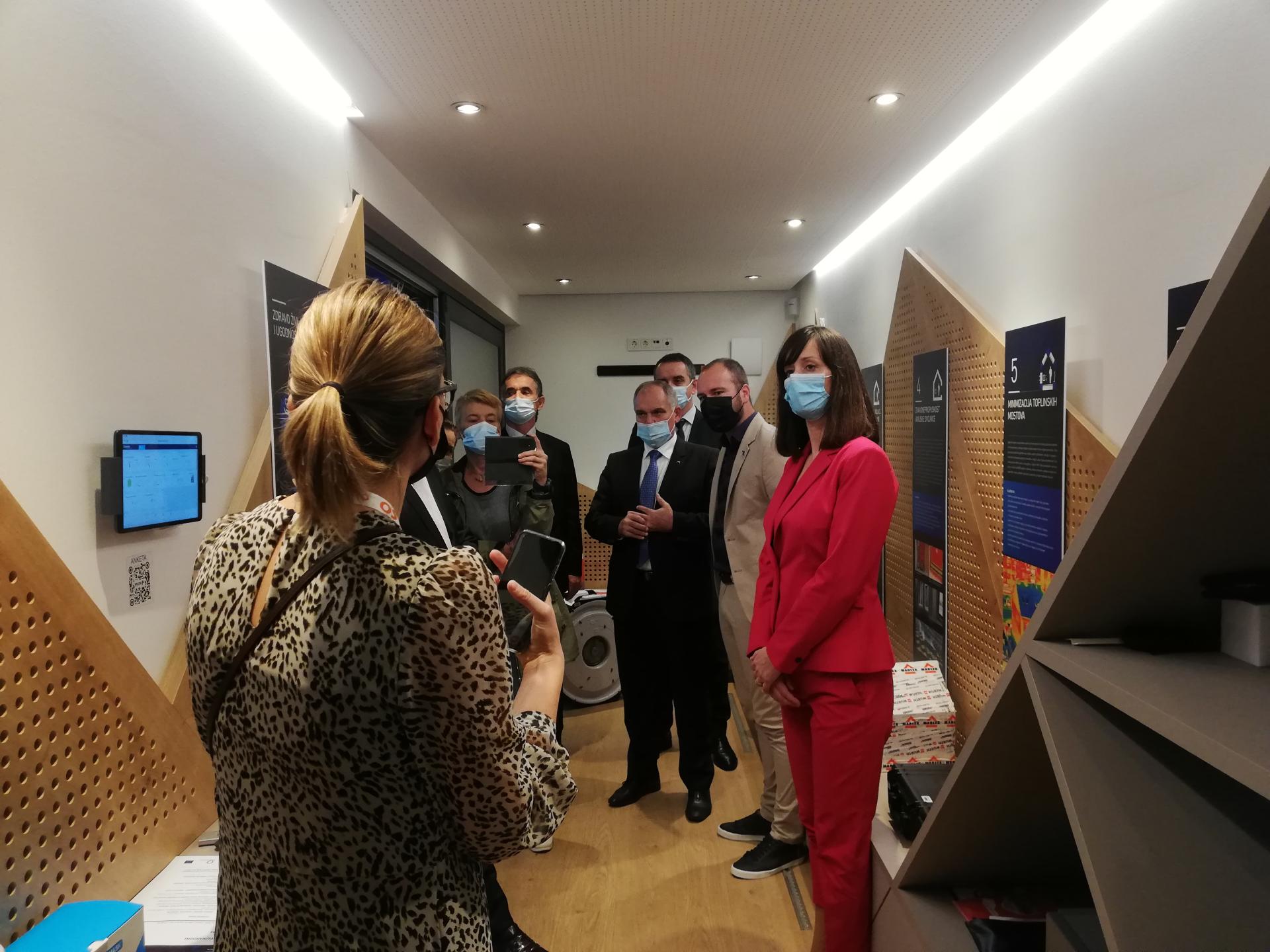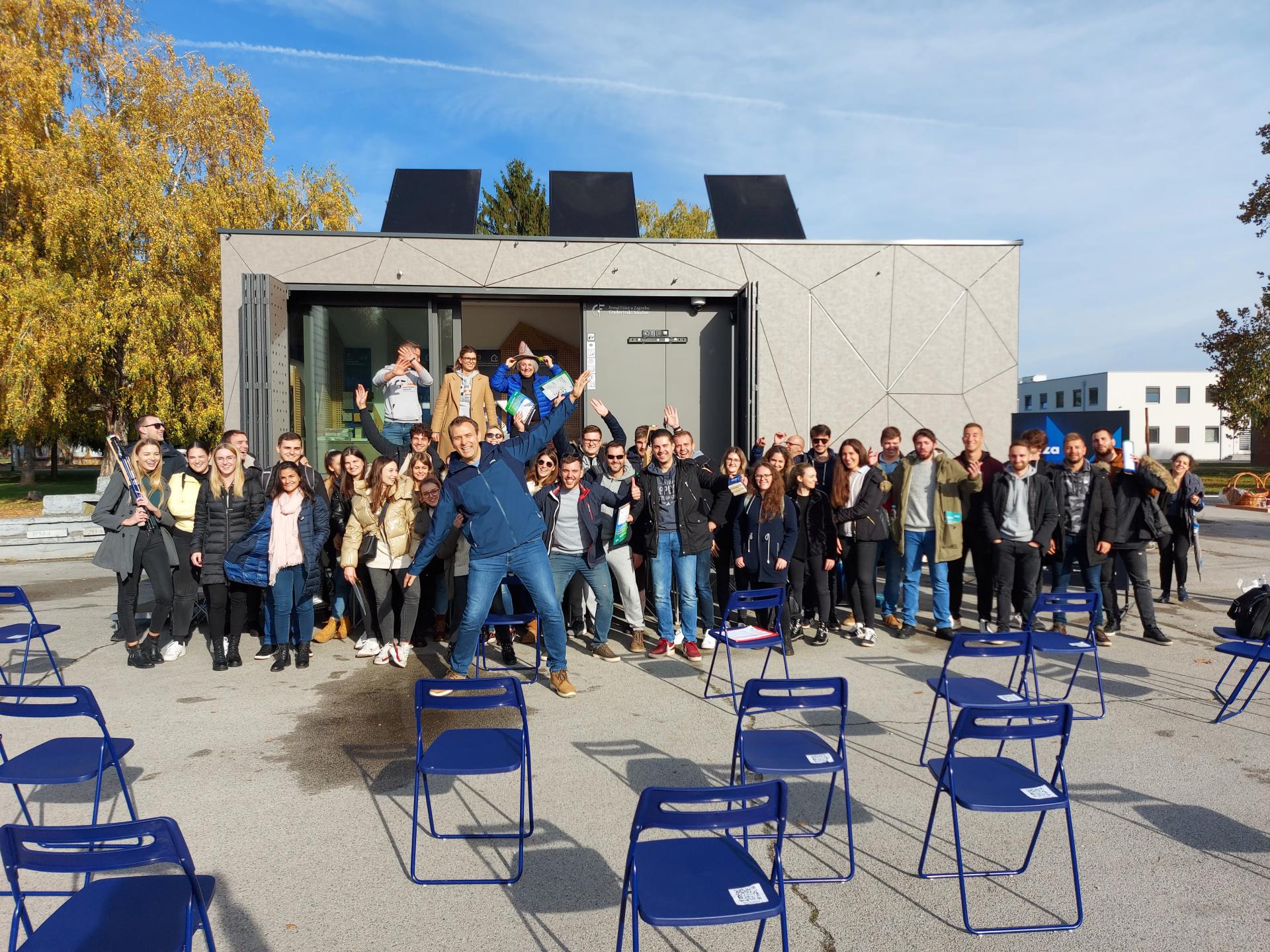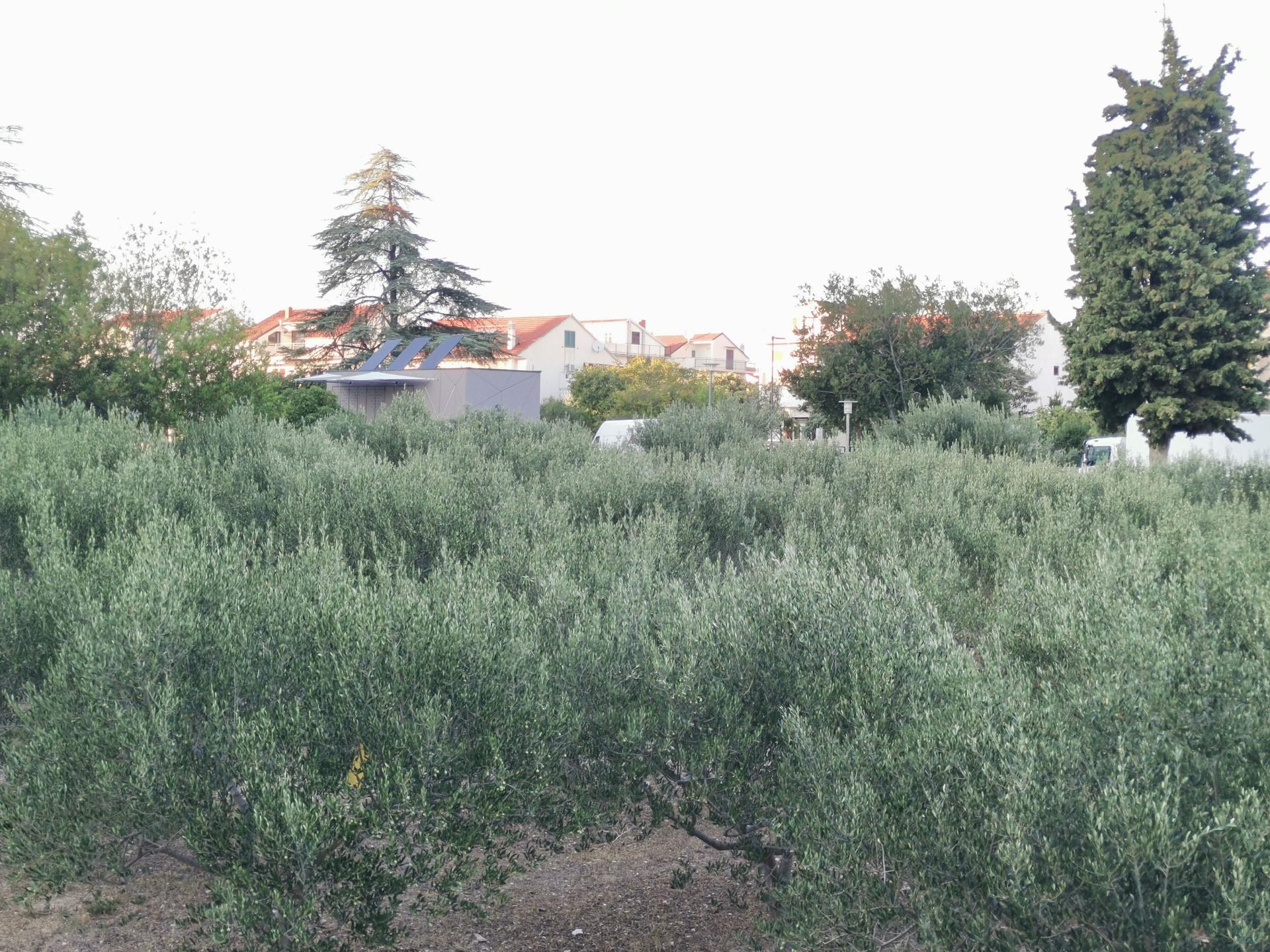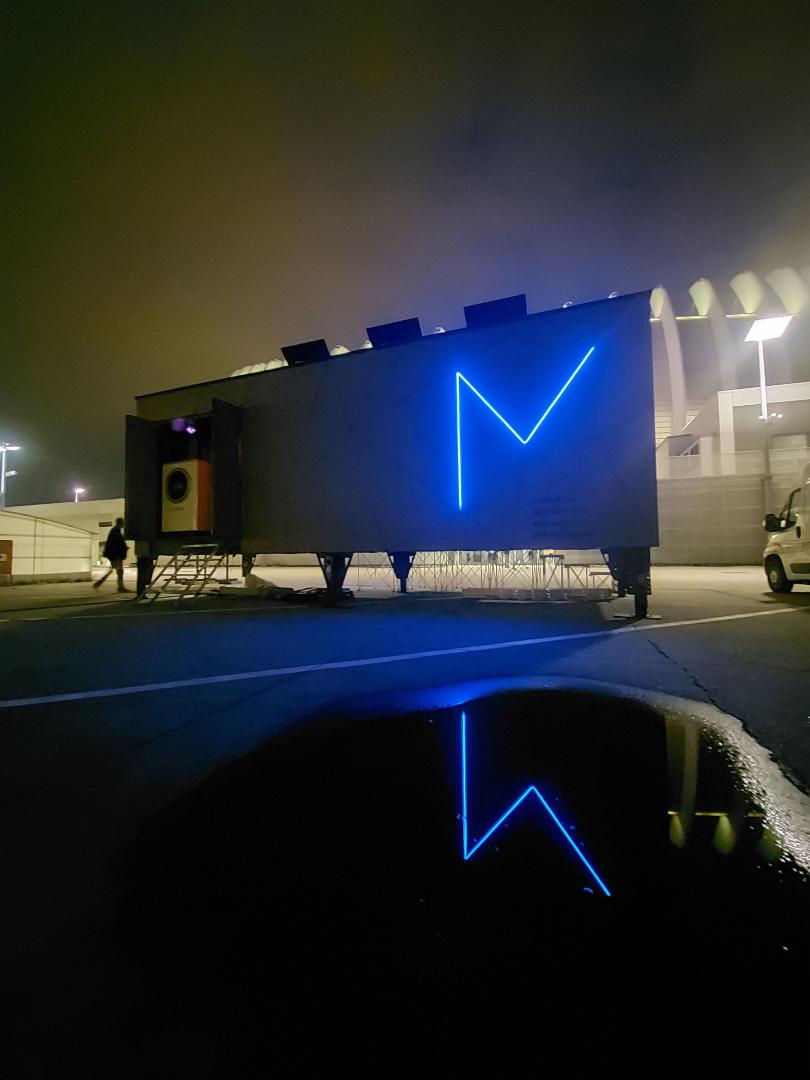MUZA - the Mobile NZEB pavilion
Basic information
Project Title
Full project title
Category
Project Description
The way we design and construct and use our buildings is changing, shifting the focus to the green building and climate-resilient buildings and communities.
The educational and fully functional mobile NZEB pavilion called MUZA explores the quality of life of occupants in design, construction, operation of NZEBs and possibility to adapt to a changing environment having in mind social aspects and human needs.
MUZA (Eng. Muse) aims to inspire people to build healthy, efficient and sustainable.
Geographical Scope
Project Region
Urban or rural issues
Physical or other transformations
EU Programme or fund
Which funds
Description of the project
Summary
Buildings form the tissue of the built environment. On the threshold of a new technological era, it seems important to refocus on the physical world around us. Although the design and construction of Nearly Zero-Energy Buildings (NZEB) has become a legal requirement and COVID -19 has shown us that our living environment affects our health and well-being, there are some mistrust and misconceptions in the public about NZEBs. Perhaps it is fear of change or “smart buildings” symbiosis, the fear that sustainability will not complement aesthetics. To overcome these obstacles and raise awareness, a state-of-the-art NZEB mobile pavilion called MUZA - Mobilna, Učinkovita, Zdrava, Arhitektura (Eng. Mobile, Efficient, Healthy, Architecture) was developed by a Croatian team as part of the H2020 project “The nZEB Roadshow”. MUZA is designed, built and equipped like a real building with the latest innovative materials, products, technologies and ideas to provide a real experience of NZEB and modern lifestyle. Visitors to MUZA are attracted to its visual appearance and engaged with comprehensive information about the processes relevant to building's performance in terms of comfort, indoor air quality, energy consumption and RES. The design and construction process lasted from 06/2020 to 05/2021, and MUZA's mobility stemmed from a desire to achieve greater diffusion of knowledge. This allowed for on-the-ground experiences to be shared with people “at their doorstep" across the country. Additional tools were also developed and prepared to facilitate the roadshow activities, such as an interactive exhibition, live demonstrations, gamification, and comic book. The activities attracted extraordinary interest from all stakeholders. From 06/2021 to 12/2021, a total of 8 roadshow events were organized, attracting thousands of visitors (involving a wide range of stakeholders). These efforts were accompanied by a very active communication campaign in both traditional and social media.
Key objectives for sustainability
MUZA's sustainability is demonstrated by:
- Lower environmental impact thanks to the materials used, highly efficient air-to-water heat pump system, mechanical ventilation with heat recovery, and installed photovoltaic panels that allow MUZA to be self-sufficient or draw very little energy from the grid.
- Long-term perspective - the MUZA will continue to be used for educational purposes to raise awareness about energy efficiency in buildings, sustainability and healthy living. Therefore, its lifespan extends beyond the official end of the NZEB Roadshow project.
- Recycling and reuse at the end of MUZA's life cycle - all installed materials, products and systems can be disassembled and mostly either recycled (load-bearing and secondary steel structures, HPL façade panels, thermal insulation, OSB panels, etc.) or reused (e.g. wooden panels of furniture, textile overhang, etc.), which sustainably reduces the amount of waste after the end of MUZA's use and reduces its impact on the environment.
- Opportunity for scientific research - real-time monitoring of energy consumption, energy production and indoor air quality parameters is an added value, also in terms of scientific research to understand the interaction building - occupants - nature.
- Developed "know-how" and accumulated experience - mobile houses are one of the promising housing solutions that are emerging, especially after natural disasters such as earthquakes (two strong earthquakes hit Croatia in 2020). Modularity and mobility make them applicable to different areas (both urban and rural) and versatile climatic conditions.
- Raising public awareness and more competent building professionals - lower overall CO2 impact, lower energy consumption in buildings, improved indoor comfort for occupants.
- Better communication and collaboration between different stakeholders - modern lifestyle, healthy living, social awareness and environmental responsibility.
Key objectives for aesthetics and quality
To achieve the set goals, the aesthetics and quality of experience of MUZA were identified as one of the priorities in the design process and in use.
- In order to attract a wide range of stakeholders and gain media attention, the construction of a state-of-the-art and very attractive mobile facility was envisaged.
- The name MUZA in English means "Muse", was taken from Greek mythology, where the Muses were goddesses who were believed to inspire painters, musicians and poets, and we intend MUZA to inspire stakeholders to broaden their horizons and to build efficient, healthy, architecture i.e. NZEBs.
- Our intention was to fascinate people with cladding, shapes, materials, technologies, comfort and connection with nature, thus triggering a paradigm shift.
- The aesthetic appearance conveys a clear and straightforward message - buildings can be elegant and attractive, but at the same time robust and resilient.
- Identity is defined by the triangular façade cladding, which is suitable for both complex urban areas and remote natural areas. The interior design incorporates the triangular pattern as well as the three textile sails that protect the large sliding doors from the sun radiation. The inspiration for the textile sails comes from sailing technology.
- The interior is designed to fully serve the occupants and to maximize their experience - interactive exhibitions, an accessible central control unit, the overall first-hand experience. A place to relax and understand how tiny house can maximise cosiness and satisfy all the needs of modern life.
- The special visual identity was developed having in mind MUZA’s appearance.
- Adaptive perforated shutters, together with two large sliding doors, play a key role in the dynamics of the building envelope, the transparency of daylight and thus visual comfort.
- The portable stage platform can be used for various outdoor activities.
- Thanks to the modular concept, a great architectural and design capacity is unlocked.
Key objectives for inclusion
Different levels of inclusion are met:
- Equal opportunities - the idea of mobile NZEB pavilion MUZA was to bring the burning topics related to energy efficiency and NZEB to small towns and local events in other events to people’s doorsteps to enable everybody to experience and learn about NZEB.
- Interdisciplinary approach to the design, construction and transportation of the MUZA mobile unit - involvement of different professions through effective communication and collaboration (architecture, civil engineering, mechanical engineering, electrical engineering, graphic design, sailing, interior design, cargo transportation, etc.).
- Mobility and adaptability to different climatic conditions and environments - geographical inclusion of rural and urban areas.
- Modularity - offers possibility for inclusion of different building uses, e.g., from private homes to office buildings, from nurseries to glamping resorts.
- Active engagement and participation of a wide range of stakeholders through tailored roadshow activities across the country (exhibitions, live demonstrations, VR and AR gamification, lectures, trainings) - engaging the general and professional public, from elementary and vocational high school and university students to engineers and workers, from non-governmental organizations to end users, as well as public authorities, the construction industry and the media.
- Raise public awareness to facilitate the incorporation of NZEB into conventional practices - inclusion of different media, from traditional to social media, both nationally and internationally, so as to address a wide range of audiences with tailored messages and approaches (interviews, TV shows, articles, social media posts).
- Different aspects of modern lifestyle as it should be today - inclusion of energy self-sufficiency, reuse and recycling possibilities after the end of building's life cycle, healthy and comfortable indoor environment for occupants, visual appearance and aesthetics.
Results in relation to category
During 06/2021 - 12/2021, a total of 8 roadshow events were organized in 5 different cities across the country. Some events lasted 3-5 days, others were one-day events. All events were organized in cooperation with public and/or local authorities, universities, NGOs and building industry. More than 1280 people visited MUZA and actively participated in the events. The profile of visitors ranged from decision makers and professionals to citizens, end users and media. A series of training courses were held, training over 1500 building professionals. These efforts were accompanied by a very active communication campaign in both traditional and social media, as this was an important factor in promoting the NZEB concept and MUZA. Before and during the roadshow events, there were numerous interviews for TV, radio, web portals, professional journals, talks with influencers, as well as the intense activity in social media. It is estimated that the number of people reached only in Croatia is over 175000.
Free consultations with various stakeholders on the topics related to NZEB have been conducted in person, by email, WhatsApp or through online platforms.
The organization of roadshow events provided excellent visibility and position to influence the policy making process, especially with regard to the design of energy efficiency support programmes and related support to education and training activities. This is exemplified by the involvement of the Croatian team in the "Expert committee for the preparation and monitoring of the implementation of regulations in the field of energy efficiency in buildings" at the Ministry of Physical Planning, Construction and State Assets, and the specific mentioning of the NZEB Roadshow project into Croatia's Long-term renovation strategy till 2050.
The annual award as the best project by the Croatian Green Building Council confirmed that MUZA is on the right track when it comes to promoting green building and sustainable development.
How Citizens benefit
Citizens and civil society visited MUZA during the roadshow events and actively participated to activities in and around MUZA. The activities were carefully tailored to their interest and background, ranging from primary school, high school and university students to professionals, families with children, and others. In addition to the NZEB-compatible materials, systems, and technologies implemented in the MUZA itself and accessible to visitors, additional tools were developed and prepared to facilitate events, such as:
- Interactive exhibition explaining basic NZEB principles, sustainability and healthy living.
- Tablets with MUZA's BIM model, a central control unit and an overview of real-time monitoring (energy consumption, indoor air quality parameters, security aspects, renewable energy generation).
- Online library of materials, systems and technologies installed.
- Live demonstrations: Blower door tests and infrared imaging, airtightness mockups, soundproof box, fire behaviour of materials mockup, security aspects of windows mockups, Condetti Creative System.
- Augmented reality and virtual reality.
- Comic book for children and brochure about MUZA.
The main benefit for end-users was that they received answers to their questions related to the energy renovation of their homes, indoor comfort and healthy living, technical systems, NZEB compatible and sustainable materials, etc. They were able to collect various product examples, brochures and contacts with industry representatives.
Vocational school and university students were intrigued by the latest developments in the building sector and hopefully motivated to specialise in this dynamic and progressive field.
Inspired by MUZA, an interdisciplinary case study competition was designed for ambitious university students with technical background (SUPEUS Case Study 2021).
Students from a vocational school used one of the roadshow events to produce a report for their school TV channel (Prva školska televizija).
Physical or other transformations
Innovative character
Mainstream practices in education follow the traditional "ex-cathedra" approach, which does not motivate students to participate in the learning process and take initiative. To maximize impact, the roadshow activities in and around MUZA used the "learning by doing" approach. In doing so, visitors gained knowledge based on their own on-site experience, especially when they actively participated in exploring MUZA and using additional tools explaining the basic NZEB and green building principles.
Lifelong learning opportunities are often limited to larger cities and knowledge can be said to be centralized. By getting on wheels, MUZA has overcome these obstacles and helped diffuse the knowledge and information to different parts of Croatia, linking large, mid-sized and small cities. Lifelong learning in area of NZEB, green building and healthy living was accessible to all interested individuals and groups, regardless of their background (stakeholder group).
The attractive and fully functional NZEB mobile unit is a state-of-the-art facility that is a best practice example and challenges conventional building practices in addition to changing common practices in education. The mobility provides the freedom to (re)erect the house almost anywhere, the NZEB design and construction ensures adaptation to a wide range of environmental conditions (from harsh to mild environments), while the modularity speeds up the construction process and opens up possibilities for different building uses and sizes (from single-family homes to office buildings to kindergartens, etc.).
MUZA aims to explore the possibilities of all that exists in the market (materials, products, technologies) and to strengthen conceptual thinking in the field of aesthetics and technology. Thus, to develop a different perspective on the standardized physical world.
Learning transferred to other parties
The potential of transferring the project’s results is evident from the approach of the other NZEB Roadshow partners and their intention to implement a similar approach in their respective countries.
MUZA's entire design process is documented with the BIM model, the detailed design project, the electrical installation project, comprehensive building physics calculations and reports. Each stage of the construction process, as well as the transportation process, is documented in detail with photos, videos and written communications. Sharing our personal experience and "know-how" in designing, constructing and transporting NZEB mobile houses like MUZA, together with the above documented information, is possible for interested parties under certain conditions. In this case, the Faculty of Civil Engineering of the University of Zagreb (UNIZAG) could play the role of consultant.
There are also open possibilities to use the mobile NZEB house MUZA for organizing various educational events, e.g. training HVAC installers and engineers on MUZA in cooperation with industry. Interested partners from industry would be responsible for selecting participants and defining the training concept, while UNIZAG would provide MUZA for the training sessions. UNIZAG could also provide trainers if needed.
If there is interest and inquiry, international roadshow activities with the mobile NZEB house MUZA could be considered.

